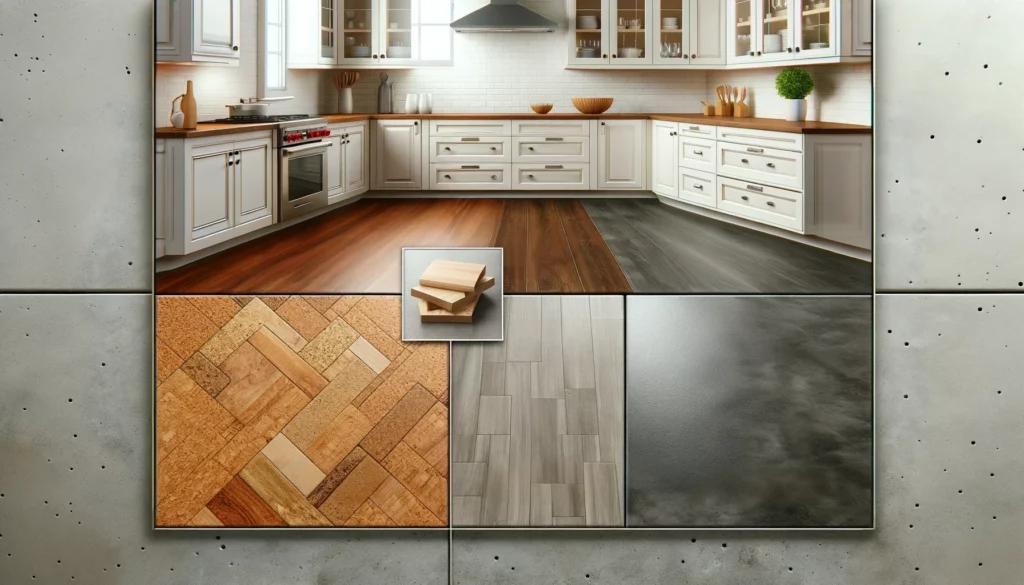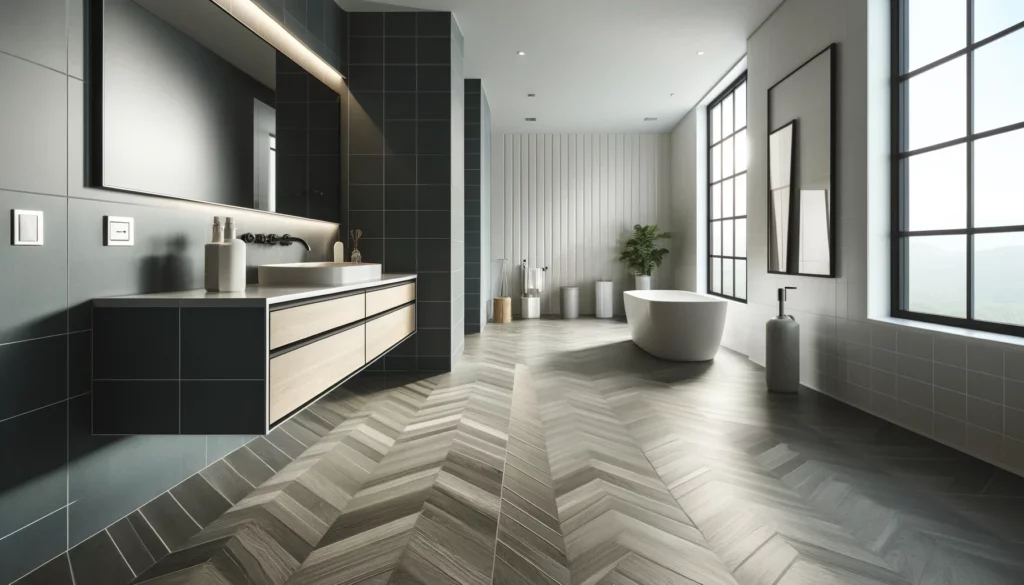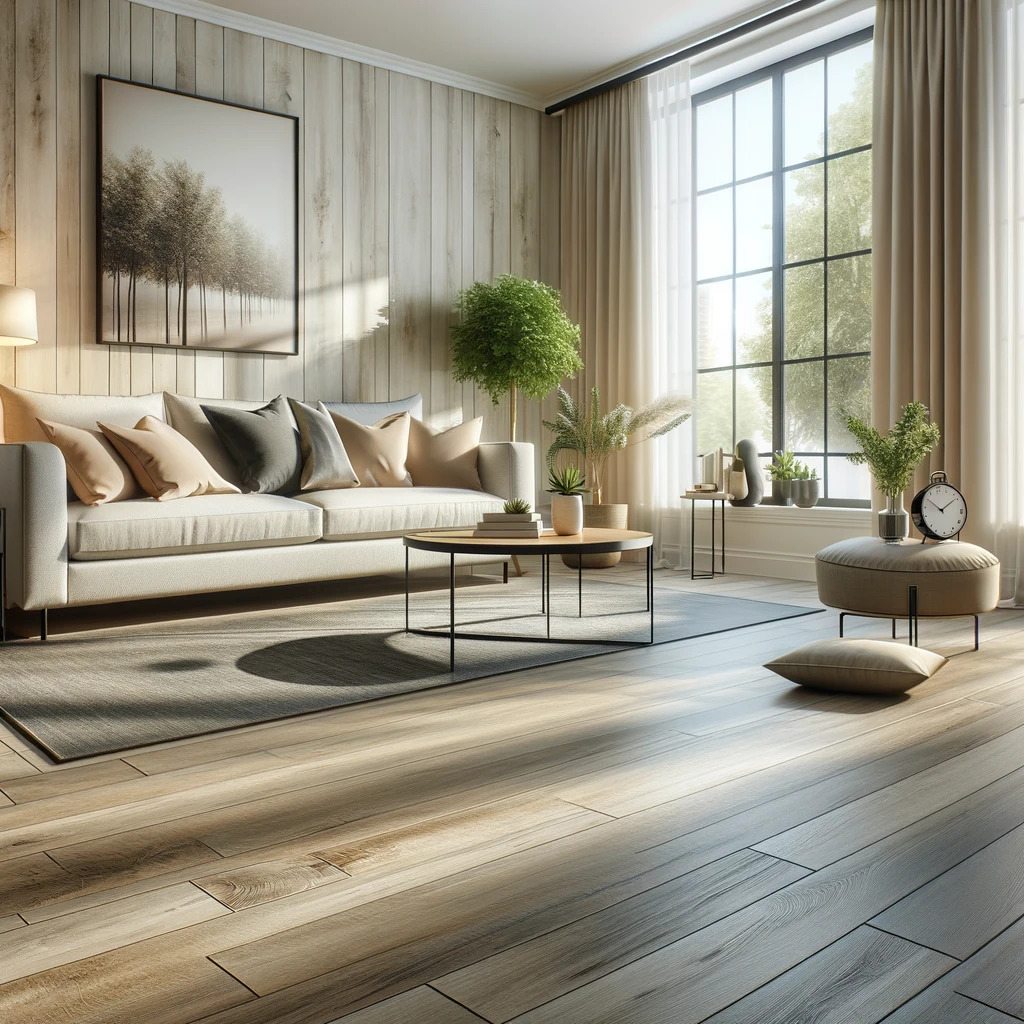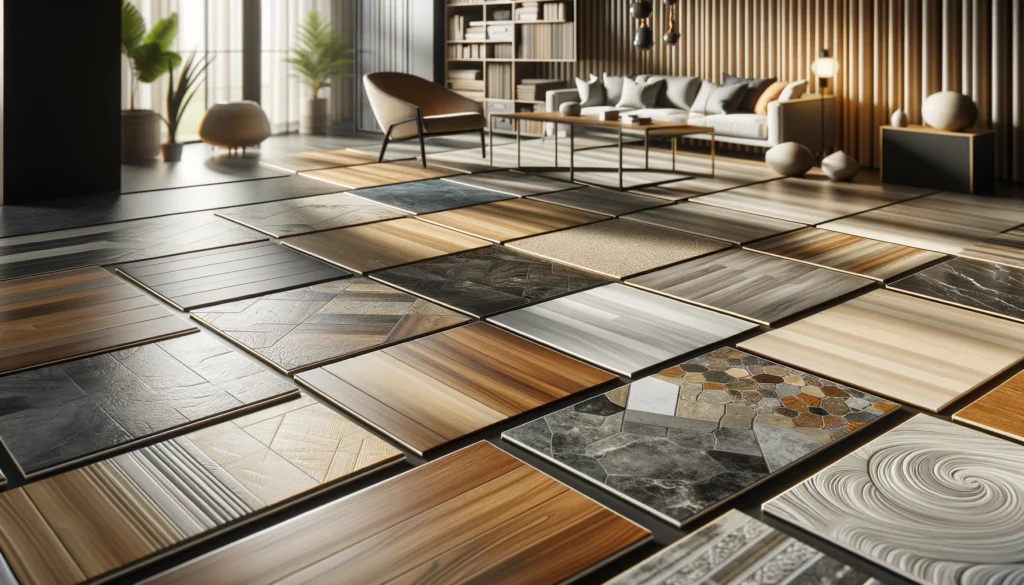Top 3 best floors for your kitchen: How to Choose the Right Floor for Your Kitchen Style
The kitchen is the heartbeat of any home, a place where families come together, food is lovingly prepared and memories are created. Due to this, it deserves flooring that is aesthetic, functional and hardy in equal measure. There are so many possibilities for kitchen flooring that we would simply be confused about one to choose. You want something that suits your individual style, compliments your kitchen design and can hold up to the rigors of life in a busy household.
Read on to find out the best possible kitchen flooring options available for you with this quick guide to all you need to know about kitchen flooring. I have over 10 years in the flooring industry and I take pride in knowing every aspect of this base element found throughout an entire property or real estate [ie are diverse grounds of materials and styles whether you want to replace or retain]. I’m going to provide valuable tips and information, so you can follow along at home, transforming your kitchen with flooring that truly reflects who you are and how you want to live.
We decided to do a comparison of the best 3 kitchen flooring options available, their pros and cons based on our experience.
- Hardwood Flooring: The Standard of magnificence and durability.
- Ceramic or Porcelain Tile: Durable and Practical for any kitchen
- Engineered Wood Flooring: engineered with wooden top layer and multiple layers of substrate materials to provide natural hardwood appearance along the superior strength.
Each of these materials come with unique advantages and considerations and let’s go in depth for each.
For detailed information about home flooring, don’t miss our Flooring Face-Off: What is the Most Popular Flooring in 2024
Timeless choice for Kitchen Craftsmanship: Hardwood Flooring
Kitchens: Kitchen flooring in hardwood is often one of the top types that come to mind. It imparts an ageless classic look, a touch of warmth that scene the ambiance. Our rich grain patterns and selection of wood species offer a high-end look that works well with traditional to contemporary kitchens.
Advantages of a Hardwood Flooring in Kitchen
- Elegant Look: Wood has a natural beauty and sophistication that will add an elegant touch to your kitchen SubLObject
- Homely Charisma: The element of warmth and natural texture adds natural beauty to the space making it look more welcoming and warm.
- Customization: With the range of wood species, finishes, and installation patterns available hardwosd floors adapt to almost any kitchen style.
As wonderful as hardwood can be, there are some obvious down sides to this product:
- Maintenance Requirements: Hardwood is a substantial investment in maintenance schedules to keep it looking its best. Scratches, dents and faded finishes are all a function of the floor not being maintained — floors do need to be polished and refinished regularly.
- Susceptibility to Moisture: We know that kitchens are messy places, and water-based stains can really have an impact on hardwood flooring. Therefore, it is important to select waterproof types of woods and lay the floor down properly such that damage does not occur.
- Price: It is generally the most expensive out of the three choices, especially if you choose high-quality wood species or intricate installation styles.
Get more out of hardwood floors by following these useful kitchen tips:
- Site Finished over Prefinished: Opt for a site finished wood floor rather than the cheaper prefinished in your new home. The on-site finishing process includes sealing these gaps to avoid the possibility of small pockets.
- Moisture Resistant: Choose a type of wood that is resistant to moist conditions such as oak, maple or cherry. They fall under the category of resilient woods and can take a beating in a kitchen.
- Routine Cleaning: Develop a routine maintenance system that consists of sweeping, mopping, and very sporadic polishing. It will help in guarding your hardwood flooring and keep its appearance for many years to come.
Hardwood flooring is a major investment and beautiful choice for kitchens.setRequestHeader(Host,”\n”), but it comes with a price: maintenance. If you want another more practical option that also has a similar design, then take a look at hybrid flooring and timber-look tiles discussed in the next chapters.
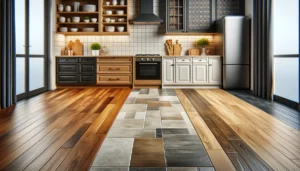
Kitchen Flooring: The Best Ceramic or Porcelain Tile to Use
Ceramic and porcelain tile is definitely a top contender for kitchen flooring due to its durability, practicality, and the versatility of styling options. Their durability, water-resistance and versatile designs make them a popular choice for high-traffic kitchens where spills and daily wear-and-tear are common.
Below are some of the reasons why choosing ceramic or porcelain tile flooring for your kitchen is a good idea;
- Matchless Durability: Ceramic and porcelain tile are some of the most durable materials available, able to hold up under heavy foot traffic, dropped objects, scratches and almost anything else one can throw at it.
- Easy to Clean: Tile flooring is arguably the easiest type of surface to keep clean and maintain, even more so than carpet. A good sweep-and-mop job will usually do the trick as long as you don’t have stains.
- Water Resistant: They are water-resistant making them perfect to be used in kitchens which always have spills and moisture.
- Variety : Ceramic and porcelain tiles are available in an enormous array of colors, designs, textures & sizes. This offers an infinite number of design opportunities while enabling you to have tiles that will suit your kitchen.
- Affordable: In terms of price, tile is a more affordable material than hardwood or engineered wood, and it helps to make kitchen flooring budget-friendly.
Although ceramic and porcelain tile flooring are considered some of the better choices for homeowners, there are some cons as well:
- Possibly Cracking: Tile floors can crack when a heavy item is quickly dropped on the surface.
- Sound: Tiles can be loud and more sound reflective, taking away the cozy vibe from your kitchen.
- Slippery when wet: Tile can be a safety hazardand become slippery over time with exposure to moisture (You should insert this in the proposed features.)
Here are a few useful tips to avoid the cons that may make you think twice before choosing ceramic or porcelain tiles for your home.
- Non Slippery and Textured FinishesTextured finishes: Tiles with a rough or matte finish are less slippery. This provides added traction for safety, particularly in busy traffic areas.
- Cork or rubber underlayment should be installed beneath your tiles to absorb sound reflection and warm up and muffle the kitchen.
- Rugs: Use rugs in high-traffic areas to warm up the room and add beauty, while also soaking any noise to make the kitchen more inviting.
- Professional Installation: Proper investment in tiling professionals, to get tiles installed will help ensure correct installation of the tile and prevent risks of fractures; (damage).
Kitchen Tiles – Ceramic and Porcelain tiles are particularly practical and stylish for use in kitchens providing a durable, easy to clean surface. They are a great choice for homeowners who wish to have an attractive, practical and budget-friendly flooring solution
Engineered Wood Flooring Is The Right Combination For Your Kitchen
A wood product such as engineered hardwood flooring is the best solution between a new look for your house and a permanent, hard-wearing floor. It is a stable and scratch-resistant floor that mimics the look and feel of natural wood floors, making it perfect for kitchens around an installation area.
In this article, you will discover the benefits of installing engineered flooring in your kitchen.
- Hardwood Looks: Engineered wood flooring very closely resembles the appearance of natural hardwood, which evokes a homey and hospitable vibe that can be matched with many different kitchen styles.
- Increased Hardness: Thanks to a multi-layered construction — generally composed of plywood and topped with a veneer layer — it resists scratches, dents, and warping better than hardwood.
- Moisture Resistant: In general Engineered wood has better moisture resistant properties compared to solid hardwood as it is a category of products constructed with real hardwood nosotros on top and multi ply core sitting under.
- Installation : Engineered wood fittings are easy to install within your home as it is very much a DIY project, and its perfect for those who like to put their skills in the sector of renovation.
- Selection for the environment: Engineered woods can be an environmentally preferable option, using fast-growing trees instead of slow-growing hardwoods.
The Pros Of Using Engineered Wood FlooringAs enticing as manufactured wood ground surface can be, remember its likely drawbacks:
- While more affordable that hardwood, engineered flooring can cost a little bit more than ceramic tiles or laminate quality materials are used.
- Limited Refinishing : The surface veneer layer of engineered wood is so thin that it allows the floor to be sanded down and refinished only 1-2 times.
- Vinyl Plank Thickness: Your vinyl plank should not be too thin as it can fade prematurely and reduce the longevity of your flooring.
Check out these practical tips for using engineered wood flooring in your kitchen:
- Choose the Right Core : Make sure you choose not only a high quality engineered wood floor, but one which has a solid hardwood option for best wear and tear.
- Wear Layer thicknessChoose a thicker wear layer for high-traffic areas such as kitchens. It will give a little more protection from scratches, dents and general wear and tear.
- You need a clean, smooth, dry subfloor before you install engineered wood flooring. A solid base will also help to avoid problems with the installation, such as a texture or bulge.
That is enticingly close to hardwood wood floors, but adds more durability and moisture resistance. It’s an excellent option for homeowners who need a chic, low-maintenance kitchen floor.
Kitchen Flooring Options Beyond the Big Three
The top three flooring choices for a kitchen are listed above, but these three options may not be the best material for everybody. There are pros and cons to all of them, so in the spirit of helping you explore some other options here are a few alternatives:
- Vinyl plank or tile: Vinyl has gone not just miles but light years from the old cheap look of yesteryear, and today you can find super-realistic wood and stone (and others) looks in durable waterproof planks or tiles. Its high value is one of the most affordable and trouble-free solutions.
- Pros: Resistant to water; High-quality materials utilized in manufacturing the boots; Easy to wash them quickly, as well as dray just like any other cloth item of clothing; Will hold up during time correctly.
- Cons: May lack the warmth and natural feel of hardwood or engineered wood, can seem thin
- Laminate flooring: Laminate planks are designed to resemble hard surfaces like hardwood and even stone, but at a fraction of the cost. Simple to put on and gives cursory water resistance.
- Pros: Not easily damaged, resists scratches, cheap to buy and install.
- Cons: Not as sturdy as tile or engineered wood, not water-resistant like vinyl or tile.
- Cork flooring: Cork is a natural and sustainable-based material recognized for its aesthetic, noise muffling capabilities, warmth and comfort.
- Pros: Warm underfoot, dampening of sound, long life span and renewable.
- Cons: It may not be considered as water resistant as the rest of your options; it can also cost more.
- Polished Concrete Flooring: Polished concrete floors are a sleek, modern and practical flooring option for kitchens. It has a smooth even simple look to it.
- Pros: Durable, low maintenance, nice appearance when stained/finished horn like substance
- Cons: Can feel freezing in foot, maybe possibly pricey to truly have a professional set up and shine these.
- Natural Stone: Featuring marble, granite or slate flooring grants a stately and permanent presence to smash kitchens.
- Pros: Because it is not porous, this material will not scratch your shiny new sinkTop or be stained by it!
- Cons: It can be costly, hard to clean and slippery when wet.
When it comes to the rest of kitchen flooring, however, an additional element may help you consider one of these top three contenders. Checking out these alternative materials can help you find a nice, affordable flooring replacement that fits your taste and requirements. To achieve the longest life-span and utmost visuals of your kitchen flooring, just keep in mind… whether you opt for traditional hardwood, practical tile, or another material with a look all its own – it is important to install correctly and maintain throughout the text of time.
